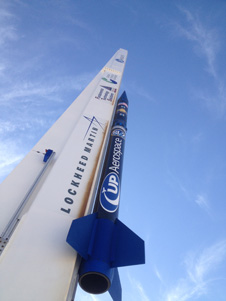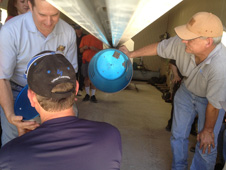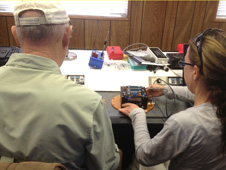 UP Aerospace SpaceLoft 7 rocket mounted on launcher the day before launch. (NASA / Leslie Williams) › View Larger Image
UP Aerospace SpaceLoft 7 rocket mounted on launcher the day before launch. (NASA / Leslie Williams) › View Larger Image
 UP Aerospace personnel load one of the technology payloads into the nose of the firm’s SpaceLoft 7 suborbital rocket in their facility at Spaceport America in New Mexico. Seven experiments were to be carried aboard the SL7 into sub-orbital space on its June 21 launch. (NASA / Leslie Williams) › View Larger Image
UP Aerospace personnel load one of the technology payloads into the nose of the firm’s SpaceLoft 7 suborbital rocket in their facility at Spaceport America in New Mexico. Seven experiments were to be carried aboard the SL7 into sub-orbital space on its June 21 launch. (NASA / Leslie Williams) › View Larger Image
 Dougal Maclise, technology manager for the Flight Opportunities Program at NASA’s Ames Research Center, and researcher Karolyn Ronzano prepare the Suborbital Flight Environment Monitor (SFEM) payload for flight on UP Aerospace’s SL7 suborbital rocket. SFEM is a monitoring system to detect environmental factors such as temperature that payloads encounter during launch. (NASA / Leslie Williams) › View Larger Image LAS CRUCES, N.M. – News media representatives are invited to witness the first research flight on a suborbital rocket funded by NASA’s Flight Opportunities Program when UP Aerospace Inc.’s SpaceLoft 7 vehicle lifts off June 21 at Spaceport America near Las Cruces, New Mexico. Liftoff is scheduled to occur between 7 and 10 a.m. MDT.
Dougal Maclise, technology manager for the Flight Opportunities Program at NASA’s Ames Research Center, and researcher Karolyn Ronzano prepare the Suborbital Flight Environment Monitor (SFEM) payload for flight on UP Aerospace’s SL7 suborbital rocket. SFEM is a monitoring system to detect environmental factors such as temperature that payloads encounter during launch. (NASA / Leslie Williams) › View Larger Image LAS CRUCES, N.M. – News media representatives are invited to witness the first research flight on a suborbital rocket funded by NASA’s Flight Opportunities Program when UP Aerospace Inc.’s SpaceLoft 7 vehicle lifts off June 21 at Spaceport America near Las Cruces, New Mexico. Liftoff is scheduled to occur between 7 and 10 a.m. MDT.
NASA has funded the flight for seven space-technology experiments to be flown in a space-relevant environment aboard the UP Aerospace suborbital rocket. The sub-orbital flight is expected to provide up to four minutes of weightlessness for testing of the experiments. The flight is expected to last about 15 minutes and reach an altitude of 74 miles, with landing targeted about 320 miles downrange on the U.S. Army’s White Sands Missile Range.
Among the payloads being carried are the Federal Aviation Administration’s (FAA) Automatic Dependent Surveillance-Broadcast (ADS-B), the Italian DTM Technologies’ Diapason as well as two high school science experiments funded by a New Mexico Space Grant.
The ADS-B is a commercial off-the-shelf tracking device for use in air traffic control and related applications being developed by the FAA as part of the Next Generation Air Transportation System. Current plans will require all aircraft and other flight vehicles operating within US airspace to be equipped with ADS-B by 2020.
The Diapason is an instrument to study nano-particle migration and capture, achieved by very small thermal gradients. The particles range from 1 micron to 1/1000 of micron. This range allows the monitoring of combustion-generated pollution, the analysis of hostile environments, and the identification of atmospheric contaminants.
UP Aerospace SpaceLoft suborbital rocket are about 20 feet long and can carry up to 110 pounds of payload. SpaceLoft 7 will be the firm’s 11th launch from Spaceport America.
Media representatives wishing to view the UP Aerospace launch should contact David Wilson, Spaceport America Media Relations, at 575-640-8228 or via e-mail at dwilson@zianet.com no later than Wednesday, June 19 at 4 p.m. MDT to arrange for access to the facility.
Officials of NASA’s Flight Opportunities Program and UP Aerospace, including Program Executive “LK” Kubendran, Technology Manager Dougal Maclise and UP Aerospace Campaign Manager Paul DeLeon, will be available for interviews after the launch. To arrange interviews, contact Leslie Williams, NASA Dryden public affairs, at 661-810-4977.
UP Aerospace Inc., based in Denver, Colo., is one of eight companies under NASA contract to fly experiments at the boundaries of space to verify the technology works as expected in this environment. The other seven companies are Virgin Galactic, Masten Space Systems, Near Space Corporation, XCOR Aerospace, Whittinghill Aerospace and Armadillo Aerospace.
NASA manages the Flight Opportunities manifest, matching payloads with flights, and will pay for payload integration and flight costs for the selected payloads. Other suborbital flight vendors on contract to NASA will provide flights after they have successfully flown their qualifying vehicles.
The Flight Opportunities Program, part of NASA’s Space Technology Mission Directorate, is managed at NASA’s Dryden Flight Research Center in Edwards, Calif. NASA’s Ames Research Center at Moffett Field, Calif., manages the technology maturation activities for the program.
For more information on the Flight Opportunities program, visit:
http://flightopportunities.nasa.gov
For more about NASA Dryden Flight Research Center, visit:
https://www.nasa.gov/centers/dryden
– end –
text-only version of this release
To receive status reports and news releases issued from the Dryden Newsroom electronically, send a blank e-mail message to dfrc-subscribe@newsletters.nasa.gov. To unsubscribe, send a blank e-mail message to dfrc-unsubscribe@newsletters.nasa.gov. The system will confirm your request via e-mail.
Leslie Williams
NASA Dryden Flight Research Center
661-810-4977
leslie.a.williams@nasa.gov
David Wilson
Spaceport America
575-640-8228
dwilson@zianet.com

























